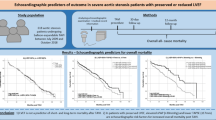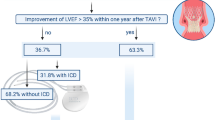Abstract
Background
Predictors of left ventricular ejection fraction (LVEF) improvement after transcatheter aortic valve replacement (TAVR) in patients with a preoperative reduced LVEF are limited.
Objectives
This study aimed to investigate the relationship between preprocedural valuvuloarterial impedance (ZVa), which represents the global LV afterload, and LVEF improvement after TAVR.
Methods
This was a single-center, retrospective study, which included patients with symptomatic aortic valve stenosis (AS) with a reduced baseline LVEF (< 50%) underwent TAVR. Based on the difference in the LVEF before and 1 month after the procedure, they were divided into two groups: improved group (≥ 10% improvement) and non-improved group (< 10% improvement or worsening). Preprocedural ZVa and clinical outcomes were then compared. ZVa was calculated using preprocedural transthoracic echocardiography data.
Results
Among 473 cases of TAVR performed from May 2012 to July 2017 at Queen’s Medical Center (Honolulu, HI, USA), 99 patients (improved group, n = 42; mean age 82.0 ± 8.6 years vs. non-improved group, n = 57, mean age 81.4 ± 9.5 years) were included. The improved group had a higher baseline ZVa {4.83 (4.15–6.89) mmHg/ml/m2 vs. 4.04 (3.56–4.63) mmHg/ml/m2, respectively, p = 0.0009} and prevalence of ZVa > 5 mmHg/ml/m2 (45.2% vs. 17.5%, respectively, p = 0.0028). Multivariable analysis of predictors of LVEF improvement ≥ 10% at 1 month identified ZVa > 5 mmHg/ml/m2 [odds ratio (OR): 3.31, 95% confidence interval (CI): 1.05–11.8] as a predictor. The improved group had a lower readmission rate due to heart failure than the non-improved group (log-rank test, p = 0.043).
Conclusion
In conclusion, Zva is a simple, noninvasive marker that shows promise as a predictor of LVEF improvement after TAVR in reduced LVEF patients.




Similar content being viewed by others
References
Carabello BA, Green LH, Grossman W, Cohn LH, Koster JK, Collins JJ (1980) Hemodynamic determinants of prognosis of aortic valve replacement in critical aortic stenosis and advanced congestive heart failure. Circulation 62:42–48
Briand M, Dumesnil JG, Kadem L, Tongue AG, Rieu R, Garcia D, Pibarot P (2005) Reduced systemic arterial compliance impacts significantly on left ventricular afterload and function in aortic stenosis: implications for diagnosis and treatment. J Am Coll Cardiol 46:291–298
Cramariuc D, Cioffi G, Rieck AE, Devereux RB, Staal EM, Ray S, Wachtell K, Gerdts E (2009) Low-flow aortic stenosis in asymptomatic patients: valvular-arterial impedance and systolic function from the SEAS Substudy. JACC Cardiovasc Imaging 2:390–399
Halkos ME, Chen EP, Sarin EL, Kilgo P, Thourani VH, Lattouf OM, Vega JD, Morris CD, Vassiliades T, Cooper WA, Guyton RA, Puskas JD (2009) Aortic valve replacement for aortic stenosis in patients with left ventricular dysfunction. Ann Thorac Surg 88:746–751
Fraccaro C, Al-Lamee R, Tarantini G, Maisano F, Napodano M, Montorfano M, Frigo AC, Iliceto S, Gerosa G, Isabella G, Colombo A (2012) Transcatheter aortic valve implantation in patients with severe left ventricular dysfunction: immediate and mid-term results, a multicenter study. Circ Cardiovasc Interv 5:253–260
Baron SJ, Arnold SV, Herrmann HC, Holmes D, Szeto WY, Allen KB, Chhatriwalla AK, Vemulapali S, O'Brien S, Dai D, Cohen D (2016) Impact of ejection fraction and aortic valve gradient on outcomes of transcatheter aortic valve replacement. J Am Coll Cardiol 67:2349–2358
Ewe SH, Ajmone Marsan N, Pepi M, Delgado V, Tamborini G, Muratori M, Ng AC, Kley FV, Weger AD, Schalij MJ, Fusari M, Biglioli P, Bax JJ (2010) Impact of left ventricular systolic function on clinical and echocardiographic outcomes following transcatheter aortic valve implantation for severe aortic stenosis. Am Heart J 160:1113–1120
Elmariah S, Palacios IF, McAndrew T, Hueter I, Inglessis I, Baker J, Kodali S, Leon MB, Svensson L, Pibarot P, Douglas PS, Fearon WF, Kirtane AJ, Maniar HS, Passeri JJ (2013) Outcomes of transcatheter and surgical aortic valve replacement in high-risk patients with aortic stenosis and left ventricular dysfunction: results from the placement of aortic transcatheter valves (PARTNER) trial (cohort A). Circ Cardiovasc Interv 6:604–614
Nishimura RA, Otto CM, Bonow RO, Carabello BA, Erwin JP, Guyton RA, O'Gara PT, Ruiz CE, Skubas NJ, Sorajja P, Sundt TM, Thomas JD, ACC, AHA Task Force Members (2014) AHA/ACC guideline 2014 AHA/ACC guideline for the management of patients with valvular heart disease: a report of the American College of Cardiology/American Heart Association Task Force on Practice Guidelines. Circulation 129:e521–e643
Lang RM, Bierig M, Devereux RB, Flachskampf FA, Foster E, Pellikka PA, Picard MH, Roman MJ, Seward J, Shanewise JS, Solomon SD, Spencer KT, Sutton MS, Stewart WJ (2005) Recommendations for chamber quantification: a report from the American Society of Echocardiography's Guidelines and Standards Committee and the Chamber Quantification Writing Group, developed in conjunction with the European Association of Echocardiography, a branch of the European Society of Cardiology. J Am Soc Echocardiogr 18:1440–1463
Magne J, Mohty D, Boulogne C, Deltreuil M, Cassat C, Echahidi N, Laskar M, Lacroix P, Virot P, Aboyans V (2015) Prognostic impact of global left ventricular hemodynamic afterload in severe aortic stenosis with preserved ejection fraction. Int J Cardiol 180:158–164
Jang JY, Seo J-S, Sun BJ, Kim DH, Song JM, Kang DH, Song JK (2016) Impact of valvuloarterial impedance on concentric remodeling in aortic stenosis and its regression after valve replacement. J Cardiovasc Ultrasound 24:201–207
Katsanos S, Yiu KH, Clavel M-A, Rodes-Cabau J, Leong D, Kley FV, Marsan NA, Bax JJ, Pibarot P (2013) Impact of valvuloarterial impedance on 2-year outcome of patients undergoing transcatheter aortic valve implantation. J Am Soc Echocardiogr 26:691–698
Ito H, Mizumoto T, Shomura Y, Sawada Y, Kajiyama K, Shimpo H (2017) The impact of global left ventricular afterload on left ventricular reverse remodeling after aortic valve replacement. J Card Surg 32:530–536
Kobayashi Y, Kim JB, Moneghetti KJ, Kobayashi Y, Zhang R, Brenner DA, O'Malley R, Schnittger I, Fischbein M, Miller DC, Yeung AC, Liang D, Haddad F, Fearon WF (2017) Dynamic changes in aortic impedance after transcatheter aortic valve replacement and its impact on exploratory outcome. Int J Cardiovasc Imaging 33:1693–1701
Lancellotti P, Donal E, Magne J, O'Connor K, Moonen ML, Cosyns B, Pierard LA (2010) Impact of global left ventricular afterload on left ventricular function in asymptomatic severe aortic stenosis: a two-dimensional speckle-tracking study. Eur J Echocardiogr 11:537–543
Levy F, Luc Monin J, Rusinaru D, Petit-Eisenmann H, Lelguen C, Chauvel C, Adams C, Metz D, Leleu F, Gueret P, Tribouilloy C (2011) Valvuloarterial impedance does not improve risk stratification in low-ejection fraction, low-gradient aortic stenosis: results from a multicentre study. Eur J Echocardiogr 12:358–363
Curtis JP, Sokol SI, Wang Y, Rarhore SS, Ko DT, Jadbabaie F, Portnay EL, Marshalko SJ, Radford M, Krumholz HM (2003) The association of left ventricular ejection fraction, mortality, and cause of death in stable outpatients with heart failure. J Am Coll Cardiol 42:736–742
Solomon SD, Claggett B, Desai AS, Packer M, Zile M, Swedberg K, Rouleau JL, Shi VC, Starling RC, Kozan O, Dukat A, Lefkowitz MP, McMurray JV (2016) Influence of ejection fraction on outcomes and efficacy of Sacubitril/Valsartan (LCZ696) in heart failure with reduced ejection fraction: the prospective comparison of ARNI with ACEI to determine impact on global mortality and morbidity in heart failure (PARADIGM-HF) trial. Circ Heart Fail 9:e002744
Quere J-P, Monin J-L, Levy F, Petit H, Baleynaud S, Chauvel C, Pop C, Ohlmann P, Lelguen C, Dehant P, Gueret P, Tribouilloy C (2006) Influence of preoperative left ventricular contractile reserve on postoperative ejection fraction in low-gradient aortic stenosis. Circulation 113:1738–1744
van der Boon RM, Nuis R-J, Van Mieghem NM, Benitez LM, van Geuns RJ, Galema TW, van Domburg RT, Geleijnse ML, Dager A, Jaegere PP (2012) Clinical outcome following transcatheter aortic valve implantation in patients with impaired left ventricular systolic function. Catheter Cardiovasc Interv 79:702–710
Carreras ET, Kaneko T, Ramirez-Del Val F, Pelletier MP, Sobieszczyk PS, Bhatt DL, Shah PB (2018) Impact of flow, gradient, and left ventricular function on outcomes after transcatheter aortic valve replacement. Catheter Cardiovasc Interv 91(4):798–805
Acknowledgements
The authors are indebted to Drs. Ramy Badawi, MD, and Jared Oyama, MD, and Mrs. Mio Osaki APRN and Vicky Crowder APRN for their care of the patients and Mrs. Sharon Uyeno for her contribution to the TVT registry data management.
Funding
This manuscript did not receive any grant or financial support.
Author information
Authors and Affiliations
Contributions
IK and CS analyzed the data and drafted the manuscript. CH and JL contributed equally to analyzing the data and editing the manuscript.
Corresponding author
Ethics declarations
Conflict of interest
Christian Spies, MD, is a consultant and TAVR proctor for Medtronic and Edwards Lifesciences. All other authors have no potential conflicts of interest to disclose with regard to any part of the data or results in this report.
Additional information
Publisher's Note
Springer Nature remains neutral with regard to jurisdictional claims in published maps and institutional affiliations.
Rights and permissions
About this article
Cite this article
Komatsu, I., Hart, C., Lau, J. et al. Preprocedural valvuloarterial impedance as a predictor of left ventricular ejection fraction improvement after transcatheter aortic valve replacement in patients with reduced left ventricular ejection fraction. Heart Vessels 35, 1209–1217 (2020). https://doi.org/10.1007/s00380-020-01591-3
Received:
Accepted:
Published:
Issue Date:
DOI: https://doi.org/10.1007/s00380-020-01591-3




